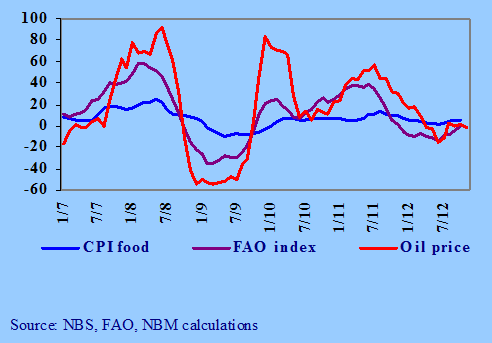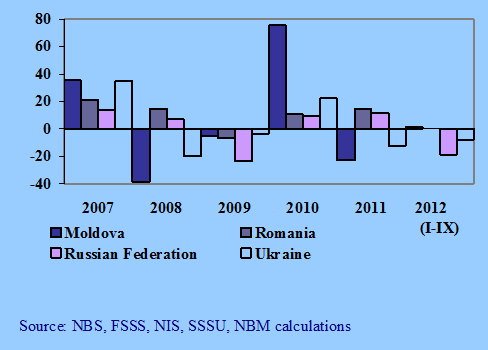Technical box extracted from:
Inflation Report no.1, February 2013
Prices exert a significant influence on the population's living standards and food prices hold the largest share in the consumption basket of the consumer price index calculated by the NBS. In the context of maintaining price stability, it is necessary to investigate, analyze and forecast internal and external factors affecting food prices. The agricultural sector in the Republic of Moldova has a significant weight in the national economy - hence the importance of internal factors influencing agricultural prices, respectively food prices.
However, a major part of the food products consumed in the Republic of Moldova are imported, which means that any influence from external factors will be felt in domestic food price developments. The most important external factors influencing food prices are:
-
international food prices;
-
agricultural and meteorological conditions in the region;
-
fuel prices.
The price volatility of agri-food prices on international markets is an important factor that contributes to food prices formation. The Food and Agriculture Organization of the United Nations (FAO) releases monthly the Food Price Index (FAO Index), which is a measure of the monthly change in international prices of a basket of commodities. The FAO Index is calculated from the average price indices of five groups of commodities (meat, dairy, cereals, oils & fats and sugar) weighted with the average export shares of each group for 2002-2004. In total, about 55 commodity prices are included in the calculation of the food price index. The advantage of using the FAO index time series in calculations, analyzes and forecasts is that it captures the price movements in external markets, which is propagated through imports in domestic food price developments. The disadvantage of using the FAO index is the volume of information that is presented and which in some cases is irrelevant to the situation of the Republic of Moldova (e.g., the prices of Brazilian sugar cane or dairy prices in Australia and New Zealand hold an important share in the FAO index, which have low correlations with the prices of this or similar products in the Republic of Moldova) (Chart no.1).
Chart no. 1. Annual growth rate of food price index and oil price (%)

Chart no. 2. Annual growth rate of price index for agricultural production (%)

The deficit or surplus of precipitation is one of the main factors that determine the amount, quality and price of agricultural production in the Republic of Moldova. Droughts have become a relatively common and predictable natural phenomenon and have already become chronic, severe droughts being recorded every 5-7 years, which cover the entire territory of the country or / and across the South East and Eastern Europe. The weather conditions are usually the same throughout the region, as droughts or floods usually occur simultaneously in the Republic of Moldova, Romania and Ukraine. Thus, the selling prices of agricultural production in the region has, in most cases, a similar pattern, which makes this indicator to be a valuable source of information for macroeconomic analysis and comparison (Chart no. 2).
The selling prices of agricultural production from the region are a useful resource for explaining and / or predicting the evolution of import and export of agricultural products in the region and, obviously, their impact on domestic food prices. For example, because of the severe drought of 2009 in the Russian Federation, the domestic market experienced a significant deficit of buckwheat and the prices for this product have tripled.
The prices for agricultural products and foodstuffs are significantly influenced, both on the foreign and domestic markets, by the energy price volatility and, in particular, fuel prices (Chart no.1). Rising oil prices, especially during seasonal work in agriculture, often contribute to increased costs for farmers, which respectively lead to higher prices for agricultural products. In addition, there is also the speculative factor and, given the multitude of intermediaries in the distribution chain of foodstuffs, the sensitivity to increasing food prices on the domestic market is significant, as a result of increased oil prices.




















